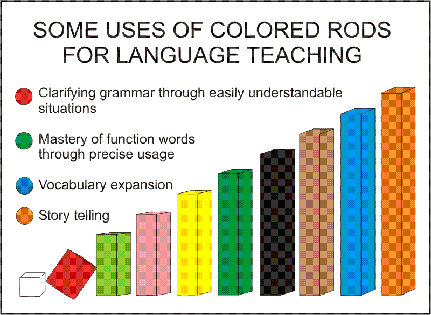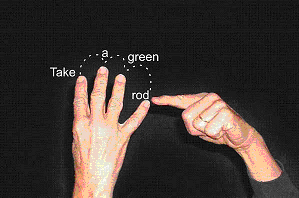Discovering the Silent Way
John and Susana Pint
INTRODUCTION
Some time ago, our friend Mario Rinvolucri of Pilgrims International Teacher Training asked us whether we would write something for beginning teachers of the Silent Way. Our first reaction was rather negative because all our previous attempts to describe this approach had met with the same fate: the more we wrote, the more we seemed to have left out. Besides, what could we say that had not already been included in the books and articles of Dr. Caleb Gattegno, the author of the Silent Way?
We cautiously abandoned our skepticism only after looking more deeply into the needs of the teachers Mario works with. Having been introduced to the Silent Way through a demonstration or a seminar, they would enthusiastically try the approach, but upon running into difficulties, most of them discovered they were isolated, far from experienced Silent Way teachers whose classrooms they might otherwise visit.
Here, we felt, was a need we might possibly be able to meet by focusing on what we have observed in our own classrooms, by concentrating on individual students and particular groups we have taught, and on the ways they gave themselves to their tasks and then by describing our own struggles, successes and failures to subordinate our conditionings to the realities before us.
So, although we have many years of experience behind us, we have decided not to write about what we know, but rather about some of the events that led to that knowledge, in an attempt to inspire new Silent Way teachers and to share with them a number of problems and questions that are well worth pondering.
We hope that no one will mistake this book for a manual or a program guide. Just as there are no two students alike, there are no two groups alike. Whatever a good teacher does to help his or her students cannot come from the pages of a book, but only from the problems created by those unique students. For this reason, we are not troubled by what we have omitted. Instead we have hope that the little we have touched on will go a long way, that this book will allow teachers everywhere to "visit" our classrooms without leaving home.
Most of the materials, games, exercises and other teaching strategies presented in this book are not ours, but were originally proposed or developed by Dr. Caleb Gattegno and form part of the approach known as The Silent Way, which is a registered trade mark. Our descriptions, however, are our own interpretation and adaptation of these materials and strategies to the particular circumstances of our own students and teaching situations.
Our deepest thanks to Mario Rinvolucri who pushed, John Morgan who pulled, Dr. Gattegno who inspired and Clif De Cordoba who provided the feedback that made all the difference.
Susana and John Pint
FOREWORD
When my friends John and Susana Pint asked me to write a word to introduce this text to the public, they did it because I am the originator of the Silent Way. I hesitated in saying yes to their request because I believe their texts do not need any introduction and can stand on their own merit. But their friendly gesture and the sense we three have that the teachers of language can be touched when reading their reports of their classroom activities took care of my inhibitions.
Here we have two practitioners, exposing themselves candidly to their readers and telling of their trepidations and mistakes, sure that these have been as much of value in their evolution as teachers as they could be to their readers and who feel at the same time that they have exciting stories to tell.
As they insist that working in certain ways can he very rewarding and choose to share their gains with colleagues everywhere, we readers can ponder upon their choice of reporting lived experiences rather than engage in a straightforward exposition of ideas they found congenial and fruitful in their case. We agree as we advance in our reading that this choice is also a proof of discipline - indeed, it is left to the reader, all the time, to decide whether his or her sensitivity has been taken into account and no forcing of one's enthusiasm is allowed to distort the evidence.
Like other readers I can state my gratitude to these two generous colleagues who, after so many years of study, came to us with simplicity and only said, "Look at this!"
C. Gattegno,
December 22, 1985
LEO AND LILIANA
Two Beginners
by John Pint
When all the students had been sorted out into various levels, there were two left. One was a middle-aged, grey-suited Austrian with a twinkle in his eye, and the other a shy little woman from Calabria, Italy. They were the only true beginners among the people who had come to Canterbury, England for a two-week, mid-summer English course and it was obvious they were going to need a teacher of their own. In a matter of minutes, I was divested of the level-two group I had been prepared for and assigned to teach Leo and Liliana using the Silent Way, a language- teaching approach based on a worldview that I have been exploring for most of my life.
The Silent Wayฎ was originated by Dr. Caleb Gattegno, a truly innovative educator, who was able to transform his extraordinary insights into practical tools for teachers. What Gattegno produced is not a method, but a flexible way of teaching based on careful observation of the workings of the mind. This study has direct classroom applications to Mathematics, Reading, Foreign Language Teaching and many other subjects. The focus is always on awareness and at every stage, teaching strategies are modified according to the demands of learning.
Over the years, various games, techniques and tools for learning were invented by Dr. Gattegno and his colleagues, but the day I met Leo and Liliana, the only Silent Way material close at hand was a bagful of colored rods. And it was the way we worked with these rods that put my two new charges on the road to learning English.

Figure 1 - Some uses of colored rods
When I teach, I am guided by feedback from the students. Therefore, as I walked in the door, I asked a few questions and attempted a simple conversation, to determine whether these two people were really the beginners others had claimed they were. At the same time, I looked at their faces, hands and postures and listened to their voices to try to find out whether they were tired, nervous, afraid, reluctant, distracted or whatever. They appeared eager, watchful, and definitely beginners, so I immediately started the lesson.
(NOTE: I began this lesson using the approach described in Gattegno's book Teaching Foreign Languages in Schools - The Silent Way. There are other ways to begin, for example by working on sounds, using charts that contain colored rectangles or colored columns of spellings representing all the phonemes of the language. Perhaps this description of how to begin with nothing but rods may benefit teachers who hesitate even to experiment with the Silent Way for lack -or fear- of charts.)
INTRODUCING THE GAME
I spread a handful of rods on the table around which we were sitting and picked one up, saying, "a rod." Then I picked up several others, looking at each one and holding it up while saying, "a rod." When I picked up the next one, I said nothing, but looked expectantly at my students. Leo said, "a rot." I took another and looked at Liliana. She said something like "rote." I quickly pointed at Leo, who said "a rot" several times. Then Liliana said "a rot" too. Picking up a number of rods, one at a time, I got "a rot" from each of them again and again.
I could accept Leo's version because it was not far off the mark and contained the schwa sound a at the beginning, which I felt was essential. The mispronunciations were relatively unimportant since, during the first moments of a course, it is necessary for non-native speakers to discover that the game I am inviting them to play is possible, even easy, and that I am offering them a way to communicate in the target language. After that, it is up to me to help them become experimenters with their vocal apparatus: to try putting their tongue into strange new positions to produce an r letting air escape through their teeth for a th; lengthening or shortening sounds to produce the English vowels. Fortunately, I knew we would have dozens of opportunities to work on that during the next hour and many more in the days to come.
I slid the pile of rods to my side of the table, leaving an empty place in the middle, to serve as a kind of stage. I placed a rod there, saying, "a black rod." I then pointed at it, looking at each of them and getting acceptable versions of the same. So, I proceeded to place a white, a green and a yellow rod on the table, each time hesitating slightly, before saying the proper words, to see if either of them might beat me to it, since it is not unusual for beginners to know a few colors or numbers. But for Leo and Liliana, every single word was a true challenge.
All of this took a minute, but it was a crucial minute during which the ease of the game was demonstrated and the rules were laid out (for example, that the teacher is reluctant to repeat and that the student is obliged to pay close attention). At the same time, I had to watch Leo and Liliana's first reactions to the rods. Their eyes told me they accepted them, and I even caught a look of relief that said, "We feel like babies in this language and are quite pleased to start with blocks rather than a grammar book."
Perhaps it is time to restate what is emphasized in the introduction to this book. What I did with Leo and Liliana was my interpretation of the Silent Way and was different from that of any other teacher. It was based on the exigencies of the moment and was not a program that I could follow again. Meeting the needs of a new group of students means finding solutions tailored to those needs. For example, when I once taught 40 people sitting in fixed rows, I regularly brought individuals to the front of the room and worked with them before turning to the group as a whole. In the case of teaching children, I tried to create an air of mystery to take advantage of their curiosity and my silence. I can only hope that the story of Leo and Liliana will leave the reader with a feeling for the complexity of creating ad hoc lessons for his or her students and the need for watchfulness at every stage.
As I held up rods of various colors, taken from the pile before me, Leo and Liliana alternated in saying "a blue rod, a brown rod, a black rod, etc." They could name whichever one I lifted, albeit with occasional hesitation and many second starts. Liliana's blue frequently became "blau", which surprised me, since blu is an Italian word. Leo's white would turn into "vite", but we had already reached a point where they would correct themselves at a glance from me, and sometimes even before I glanced.
Next I drew the pile close to me and quietly scattered about 15 rods around the table, some standing, some lying on their sides. My aim was partially to avoid monotony, which soon would have occurred if I had continued lifting rods into the air in exactly the same way. I now pointed at a rod here and another there and they began to name them as quickly as they could. This variation of the lifting-one-by-one exercise allowed me to go much faster and to challenge each of them by moving up or down to their maximum speed in naming the rods.
I could see that they were ready to go a step further, so I carefully gathered all the rods into one pile and pushed it in front of Liliana. These two actions, performed in complete silence, let them know that something new was coming and focused their attention on the right spot. In moments such as this, the burden of responsibility for looking and listening is clearly placed on the students' shoulders. The fact that the teacher simply moves on to something new without commanding the class to pay attention helps create, from the outset, an atmosphere conducive to learning. "Take a blue rod," I said to Liliana, and she reached out and took one. I was impressed, since this was my first mention of the word take and almost always I have had to physically guide a student's hand through the motions of taking to make the meaning perfectly clear.
"Take a red rod... take a green rod..." Success. Liliana was listening to instructions in a new language and doing just what a native speaker would do. But when I dramatically changed places with her and waited for her to give me the instructions, she went red with embarrassment and could barely manage to mutter, "a yellow rod" while pointing to the one she wanted me to take. Leo, however, had been observing carefully and had caught that essential first word. "Take a yellow rot," he said boldly.
LOOKING FOR THE INVISIBLE
The invisible was already becoming visible. I was discovering that Liliana could make great and sometimes unaccountable leaps forward, but was completely unaccustomed to focusing on details, whereas Leo spotted details readily, but would occasionally close his eyes and withdraw, apparently to work out a logical explanation for some new word, while muttering to himself in German.
All of this was vital information I would need in order to do my job as a teacher, which is to work on the students while they work on the language. The "program" for this particular group of students would have to include actions on my part to help Liliana look at or listen to one thing at a time, to focus her attention, while at the same time helping Leo to suspend judgment and play the game of learning a language which is frequently illogical. Only 15 minutes had gone by, but much had already come to light.
I pushed the pile of rods in front of Leo. As soon as I said, "Take a yellow rod," he did so, but I quickly added, "and give it to me," placing my hand before him, palm upward. Wrinkling his brow, Leo carefully repeated this new command: "and
give
it
to
me," after which he put the rod in my hand.
I now moved the rods in front of Liliana and gestured to Leo that he should speak to her. Of course, he immediately said, "and give it to me". I held up both hands, one in front of each student, indicating stop the action,

Figure 2 - Stop!
and then mimed taking a rod. A light dawned in Leo's eyes. Obviously Liliana had to have a rod before she could give one! "Take a white rot," said Leo, now with a fine w. Liliana took the right rod and tried to place it in Leo's outstretched hand. But he quickly withdrew it, shaking his head and lifting his shoulders in a way that meant wait a minute! "
and give it to me,' said Leo, opening his hand once more. She did so. Then they both smiled and looked at me as if to say, "We've got it - what's next?"
Naturally, what came next was practice. Leo had apparently understood the meanings of the two commands. If so, he needed to move from his new awareness to the familiarity that comes with usage. As for Liliana, I had no idea what, if anything, she had grasped. To give her another chance to watch the sequence of words and actions, I slid the rods in front of myself and gestured to Leo to give me the orders.
"Take a green rot... and give it to me." I did so and gestured for him to go on to another color. "Take a brown rot-" I held up my hand, shook my head no and then cupped my hand to my ear while making a circular movement with my outstretched index finger. This movement they would soon associate with repeat it.

Figure 3 - Please repeat
Leo caught the idea and started again, but I immediately stopped him and gestured that he should speak very slowly. I then held up four fingers. As he said, "Take
a
green
rot," I pointed to each finger, one word per finger. Then I tapped the finger representing "rot"

Figure 4 - one word per finger
and shook my head with a look that said no good. "Rot
rot
," said Leo, mystified. I again shook my head and looked at Liliana. "Rote?" she offered. No, I gestured. "R-rode?" she said. I smiled and made the repeat gesture. As she said the word, I opened my mouth wide, at the same time indicating something similar with the thumb and index finger of one hand.

Figure 5 - Open wider, please!
WORKING ON LILIANA
At last, I turned toward Liliana. Speak to me, I gestured. Very slowly and quietly, she said, "Take a blue rod," which I did. Then she turned toward Leo with a look that said, Now comes your part. But I quickly cupped my hand to my ear and looked straight into her eyes. To make things even clearer, I opened her clenched fist palm upward and dangled the blue rod above it. "G-give me," she said. I shook my head. She tried "Give-a me," and again I held back the rod. Then she looked at Leo with pleading eyes. "Give it to me," he said, and so, I immediately gave it to him, not to Liliana. All three of us laughed and I then used the put-the-words-on-the-fingers technique to help Liliana focus on what she was missing.
She soon could do as well as Leo.

(The pages above are part of Discovering the Silent Way by John and Susana Pint, a displaced -if not quite lost - manuscript which hopefully will be published in 2005, the twentieth anniversary of its writing. For more information, please contact us through www.saudicaves.com/silentway .
John and Susy Pint

Please check the Creative Teacher course at Pilgrims website.


|